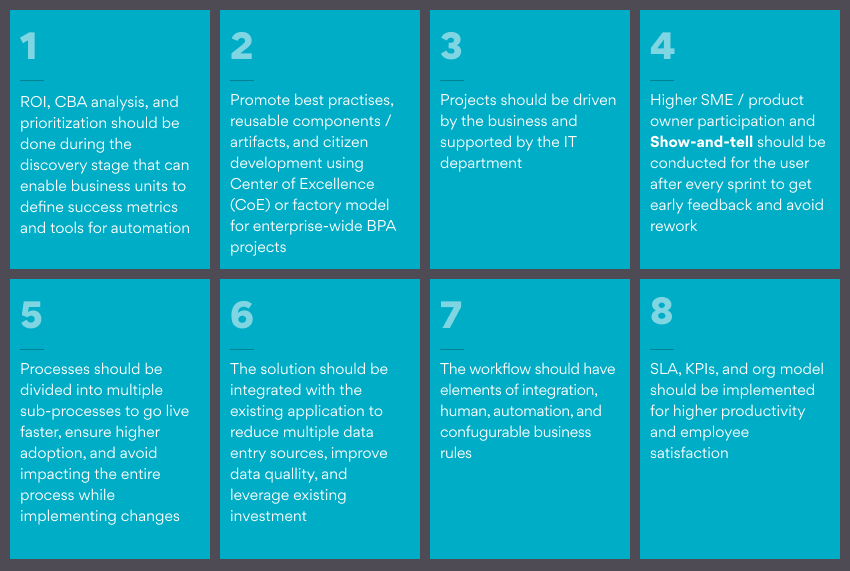In light of the current digital transformation ‘wave’ in the new normal, Business Process Automation (BPA) has become imperative, with more than two-thirds of the surveyed companies piloting their automation journey in the last two years, according to McKinsey. A successful BPA implementation can help businesses address critical issues and significantly improve coordination between teams, resulting in more wholesome and accurate data. It can help run more processes with lesser effort and fewer unforced errors. Most significantly, it can help organizations overcome issues related to data governance, customer service, operational efficiency and productivity, process automation, KPIs, SLA control, costs, and much more.
Even so, not all automation projects succeed. Based on our decades of experience in the Intelligent Automation space, we’ve identified a few pitfalls that many BPA projects face – and how organizations can avoid them to truly reap the benefits of BPA.
Suggested read: Intelligent Operations: When Business As Usual Isn’t Enough
Common Pitfalls to Avoid for a Successful BPA Implementation
Not doing due diligence for selecting the right processes
Automating a process without proper evaluation and ROI or cost-benefit analysis can result in loss of precious organizational time, money, and energies. Organizations need to establish criteria that qualify which processes/functions can and need to be automated as well as identify between workflow-driven, document-centric, and Robotic Process Automation.
As we’ll see below, processes might also need tweaking and changes before they can be successfully automated. To refine the process selection, organizations need to establish digital process automation guidelines, best practices, define success metrics, SLAs and KPIs, ROI, checklist, governance, adoption guidelines that enable organizations to decide which processes and steps are viable to improve workforce productivity and bring cohesiveness in process automation.
Lack of defined scope and benchmarking
One of the most critical first steps of a BPA project is to define its scope, success metrics and benchmark the current metrics. An unclear scope at the outset can significantly impact operations and data quality in the later stages due to repeated changes. It is also imperative that the scope includes the expected value-add, including indicators such as processing time, cost savings, revenue metrics, and staff overtime expenditure. On the other hand, without benchmarking parameters like response time, volume handling capabilities, and so on, organizations cannot truly evaluate the benefits of automation.
Opting for siloed automation instead of end-to-end automation
Automation silos occur when the approach to identifying and automating processes is disconnected or if organizations take an opportunistic approach to automation without considering the overarching goals. Such approaches fail at building a seamless digital channel across functions and departments, suffering massive operational costs. Implementation engineers must undertake employee/team surveys to identify their most significant challenges and pain points and incorporate them in their toolset evaluation.
It is also important to ensure that relevant data is being integrated and multiple sources of entry are avoided. This will ensure high quality of data and reduce manual errors. For larger programs/projects, organizations should adopt multiple phased releases. To avoid any major impacts while making new changes, the development should happen as a granular process.
Ignoring the human element in process automation
Automation needs to work for the people and not the other way around. Employees need to be informed on how the project will benefit the organization and how their skill sets will be utilized post the automation journey. Having transparent communication between the project stakeholders is equally important as having the best tools and platforms for the project’s success. Additionally, the key stakeholders also need to have a say in the process to ensure that all workflows have been covered and unexpected errors are reduced post-completion.
Ignoring change management after implementation
Improper change management and communication can result in challenges such as reluctance to embrace the changes, disruption in team communication, fear of losing jobs to automation, delays in executive buy-ins, and limitations in leveraging the benefits. The business process and its use by stakeholders need close monitoring after implementation.
Not driving the automation centrally
A Center of Excellence model helps organizations to provide best practices and governance for the project, along with Standard Operating Procedures (SOP), Responsibility Assignment Matrix (RACI), templates, etc. to the implementation team. Not having a good CoE model can result in wastage of resources, higher operation costs, inconsistency in providing services and products, and most importantly, loss of knowledge. Having no clear ownership and accountability can directly affect productivity measurement. Furthermore, without a CoE model’s guidance, it is difficult to assign the SLAs and KPIs that impact quality metrics.
Guidelines for Successful BPA Implementation

Persistent provides high-quality and efficient end-to-end BPA solutions, keeping in mind our customers’ vision, mission, and goals. Persistent’s Intelligent Automation Center of Excellence focuses on helping organizations achieve operational excellence in a cost-effective way. See how Persistent helped improve a major pharmaceutical giant’s compliance and process management and enabled modernization across product lines for a prominent insurance provider.
To learn more about how we can help you implement BPA solutions within your business, visit or reach out to our experts today.
Authors
Preetpal Singh
SVP – Intelligent Automation at Persistent Systems
Kamal Jhurani
Principal Solutions Consultant






